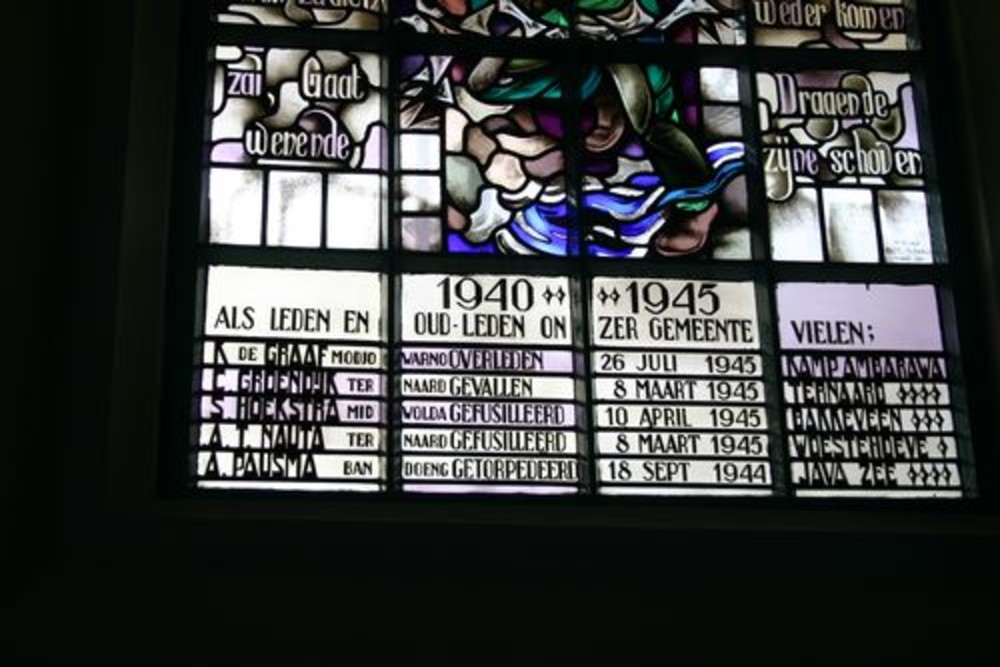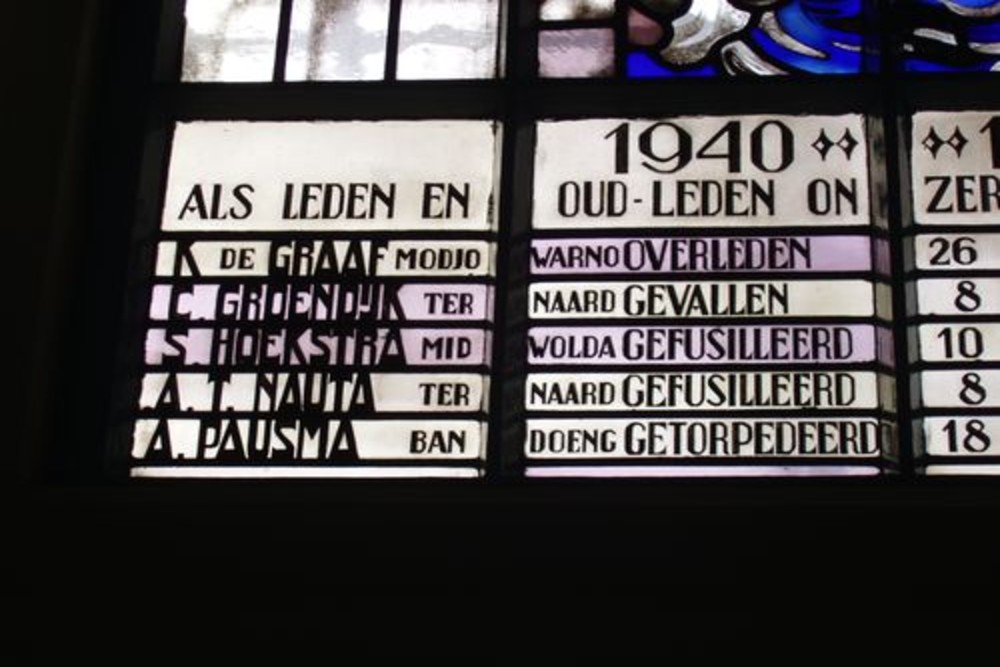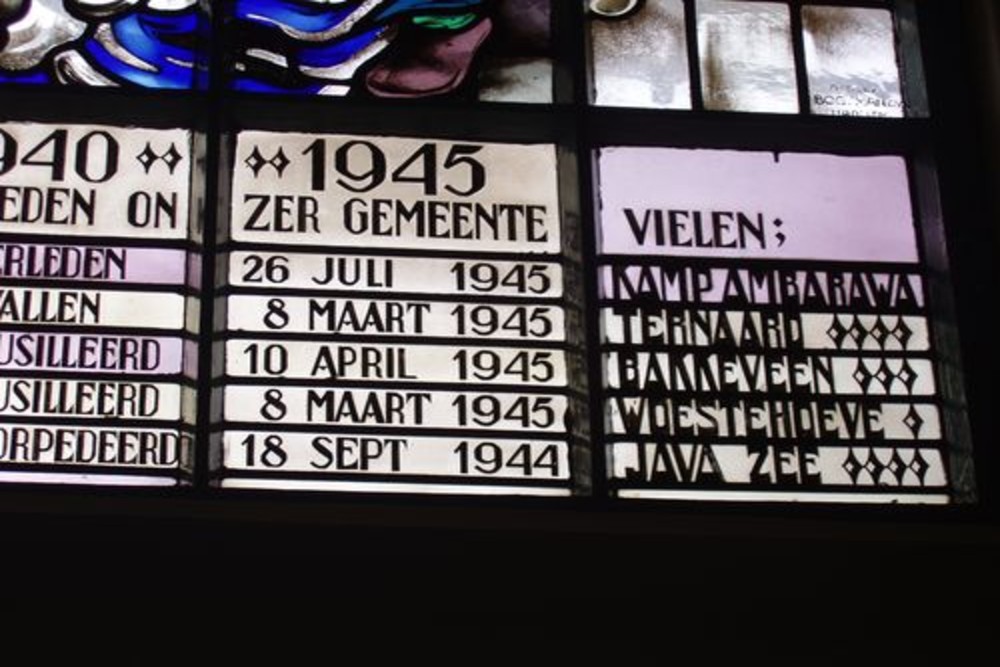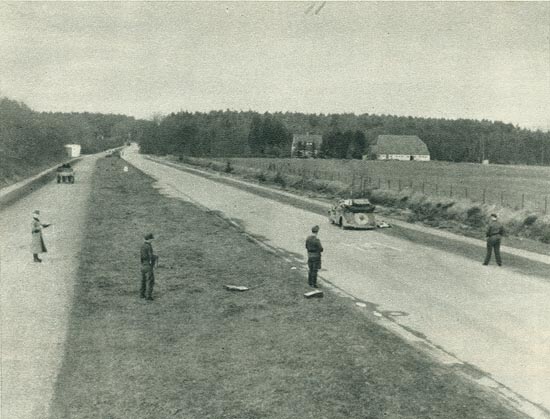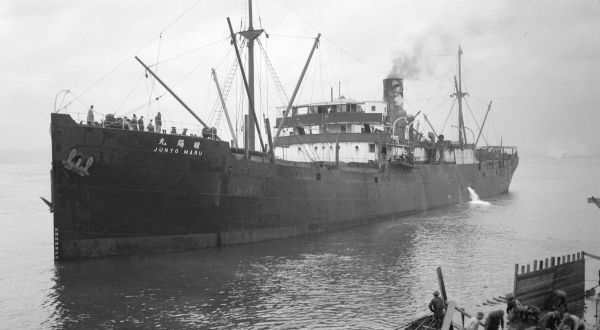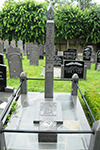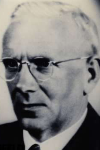Memorial Window Dutch Reformed Church
The memorial window in the Reformed Church was founded in memory of five members and former members of the reformed church who died in war during the occupation.
The names of the five victims are:
Klaas de Graaf, Cornelis Groendijk, Sijbe Hoekstra, Albert T. Nauta and Ale Pausma.
Klaas de Graaf was born on November 30, 1909 in Ternaard. In 1928 he went as a missionary to the former Dutch East Indies, where he was arrested after the Japanese occupation. He ended up in a camp where the Japanese flag was hoisted every day in the presence of all the prisoners. According to the occupying forces, De Graaf did not behave respectfully enough during this ceremony. He was transferred to the prison of Meester Cornelis near Buitenzorg. There he became the confidant of many prisoners. He later ended up in the notorious Ambahrawa camp, where about 150 prisoners per day died of an edema epidemic. De Graaf also fell ill and on the evening before he died he asked a fellow prisoner to read Matthew 24, verse 13 for him: 'But he who endures to the end will be saved.' On the basis of this text, De Graaf then gave a sermon to his fellow sufferers. That same night on July 26, 1945, he died.
Cornelis Groendijk was born on September 20, 1883 in Den Helder. He was a notary in Ternaard. Meetings of the resistance movement were regularly held in his house, partly because it was a good hiding place. The Groendijk family also included the Jewish boy Leo de Smitt (who survived the war). When the occupying forces raided the village in early March 1945, the hiding place was discovered. A son of the notary and Albert Douwes Nauta were arrested. A third person in hiding, S. Sikkes (son of the constable), managed to escape. Groendijk jr. and Nauta were locked up in the local inn, from which they managed to escape. They went into hiding on Rinsma's farm. On March 7, civil-law notary Groendijk received a warning that he was also wanted to be arrested. He immediately went into hiding. When he encountered a German patrol the next day, he immediately turned back. This aroused suspicion. Groendijk was summoned to get off his bicycle, but did not follow this order, after which the occupier shot him. He died on the spot. Groendijk was buried at the N.H. cemetery in Hoorn on Terschelling.
Rev. Sijbe J. Hoekstra was born on August 14, 1908 in Burum. During the occupation he was pastor of the NH Church in Midwolda. In this village he also did illegal work for the National Support Fund (N.S.F.) and was part of the Ordedienst. On April 10, 1945, Rev. Hoekstra was executed together with nine other Groningen resistance fighters at the edge of the forest near the Nije Drintse Wei under Bakkeveen. Since April 10, 1952, a monument has stood at the place of the execution.
Albertus T. Nauta was born on February 10, 1923 in Ternaard. When Nauta was called up by the occupying forces for compulsory labor in Germany, he refused and had to go into hiding. Through the mediation of Berend Hannema and his friend Rev. Pasma in Almen, he ended up with farmer Wilgenhof in the village of Harfsen. Together with the Frisian Ynze Dikkerboom, Nauta formed the pivot of the Knokploeg group Laren. When the ground got too hot under their feet, the resistance fighters dug an underground abode called the 'Hol'. In October 1944, the occupier became aware of this hiding place. When a number of hand grenades were thrown into the cave, Dikkerboom and his girlfriend Christine van Heesch, who were hidden in the third compartment, were killed. Nauta was not present in the den at the moment. When a member of the KP was arrested on 29 January 1945, it turned out that he was carrying the address of 'Appie' (Nauta's resistance name). That same night, Nauta was arrested. After interrogations, he was transferred to Oxerhof in Colmschate via the Landwacht barracks in Deventer. Nauta was one of the 117 men who were shot at the Woeste Hoeve on 8 March 1945 as a reprisal for the (failed) attack on SS chief Hans Albin Rauter. On June 14, 1945, Nauta was reburied at the N.H. cemetery in Ternaard. On 14 January 1983 Albertus T. Nauta was posthumously awarded the Resistance Memorial Cross by Royal Decree of 29 December 1980.
Ale Pausma was born on September 20, 1898 in Ternaard. In 1924 he left for Nijverdal. He later became a teacher in Bandoeng. As land storm sergeant 1st class, Pausma was taken prisoner by the Japanese occupiers. He died on September 18, 1944 aboard the 'Junyo Maru', when this Japanese ship was torpedoed near Padang (off the west coast of Sumatra) by HMS Tradewind of the Royal Navy at about 4 o'clock in the afternoon. Commander of the Tradewind was Lieutenant S.L.C. Maydon.
Do you have more information about this location? Inform us!
Source
- Text: Bert Deelman
- Photos: Bert Deelman
- Nationaal Comité 4 en 5 mei
- De Woeste Hoeve
- Monument Bakkeveen
- Oorlogsgraven Hoorn
Related books
Nearby
Point of interest
Monument
- War Memorial Ternaard - Ternaard
- Memorial Food Transport Holwerd - Holwerd
- Monument Droppinghiem - Aalsum
Cemetery
- Commonwealth War Graves Protestant Churchyard Ternaard - Ternaard
- Dutch War Grave Protestant Churchyard Ternaard - Ternaard
- Commonwealth War Graves Protestant Churchyard Wierum - Wierum
Remembrance Stone
- Stumbling Stone Van Aylvawâl - Holwerd
- Stumbling Stone Visweg 1 - Holwerd
- In Memoriam Grave Lombok Expedition Roman Catholic Cemetery Dokkum - Dokkum
